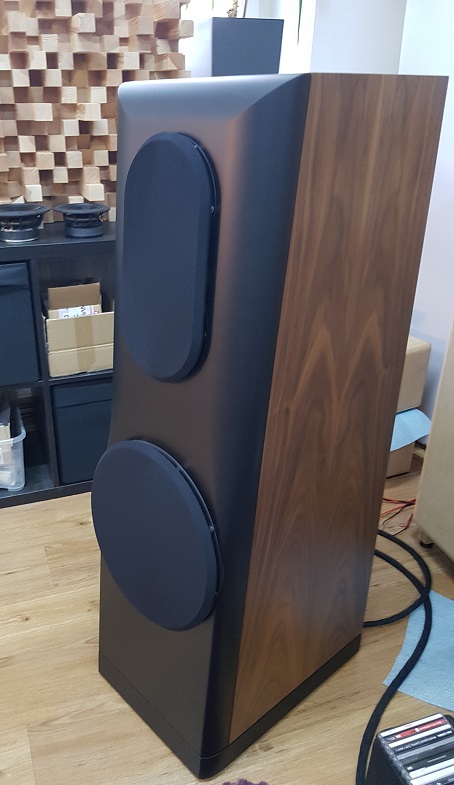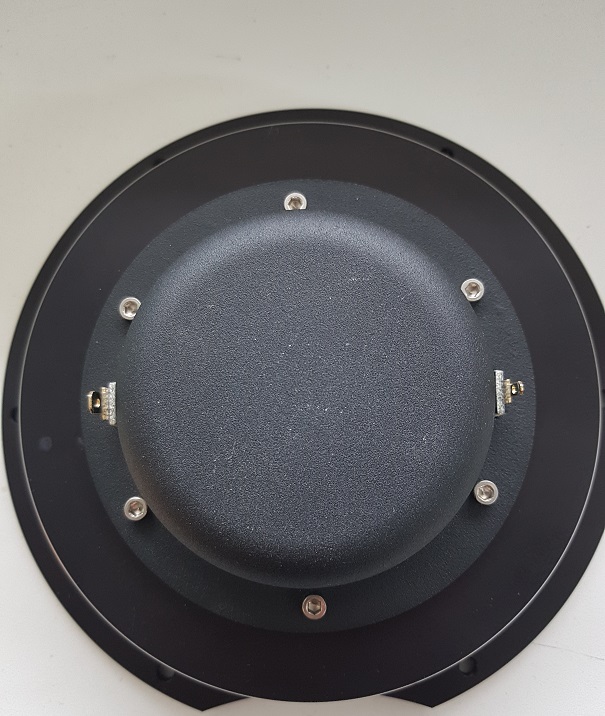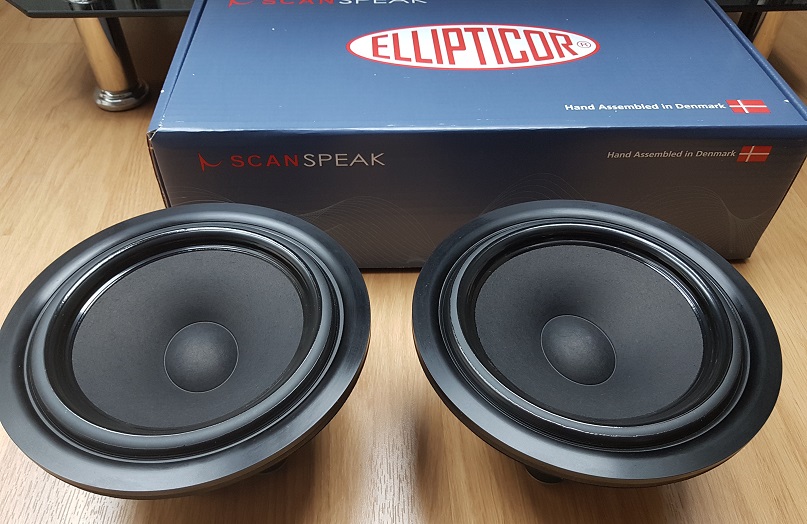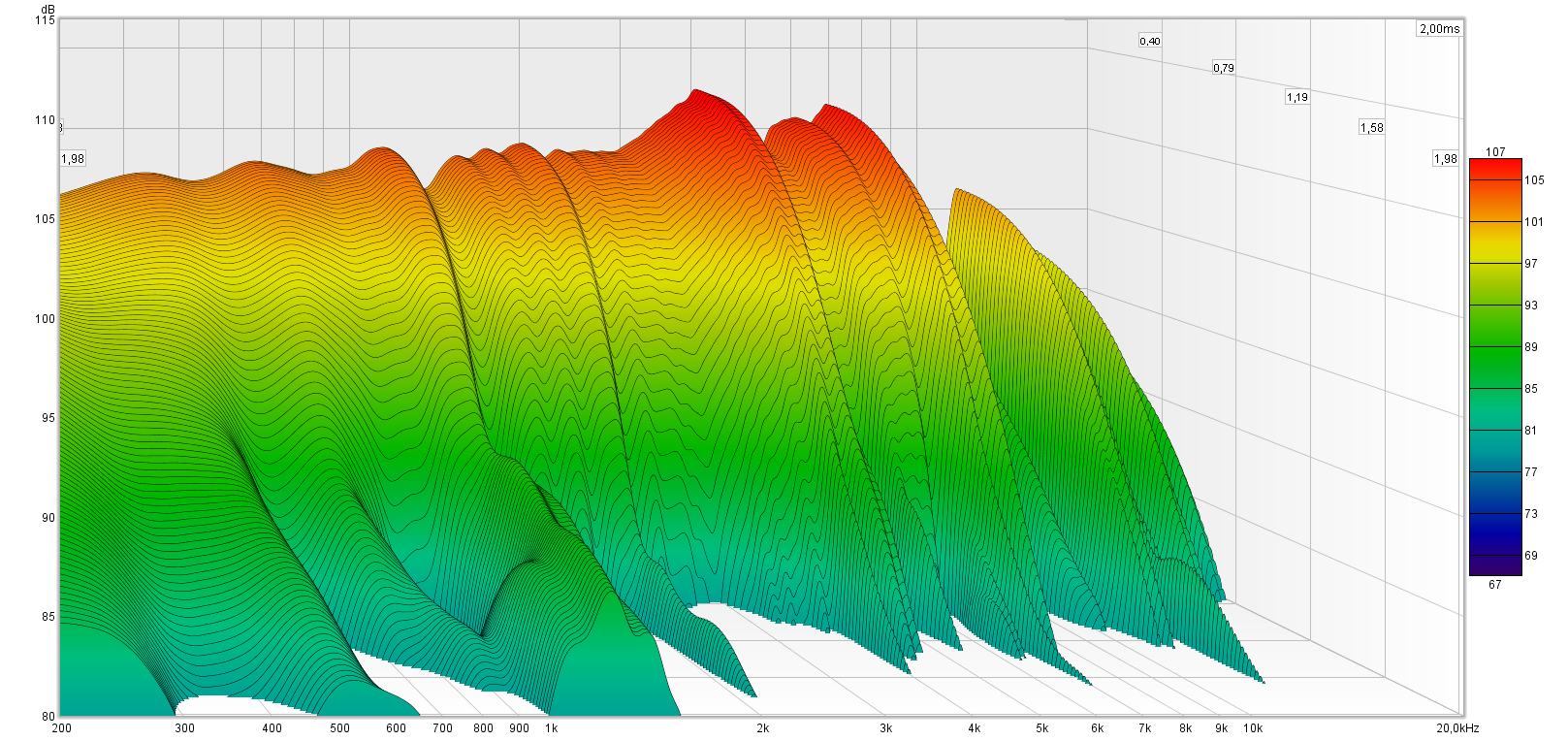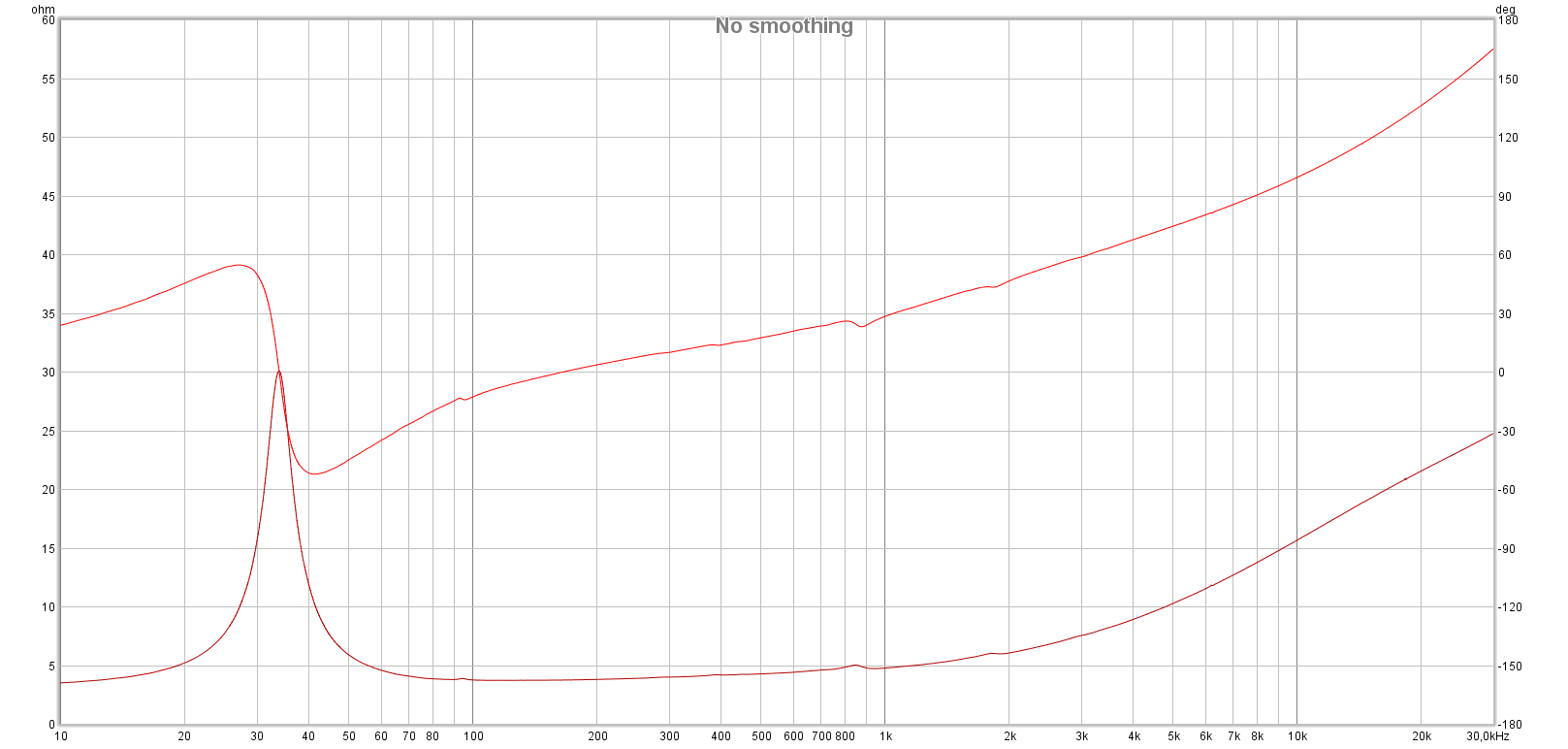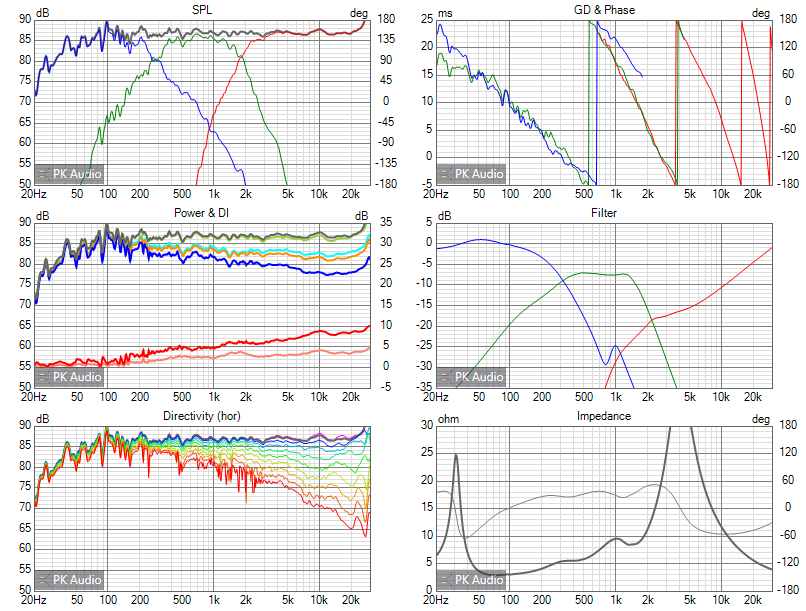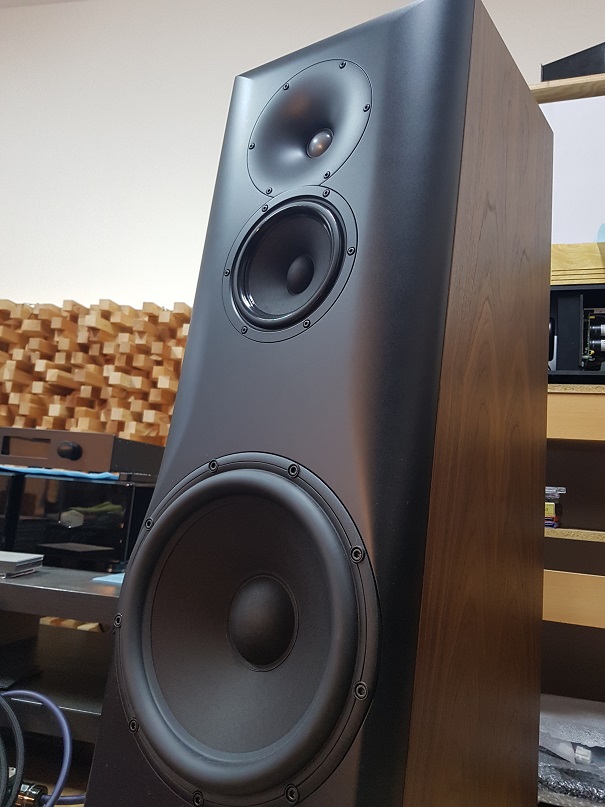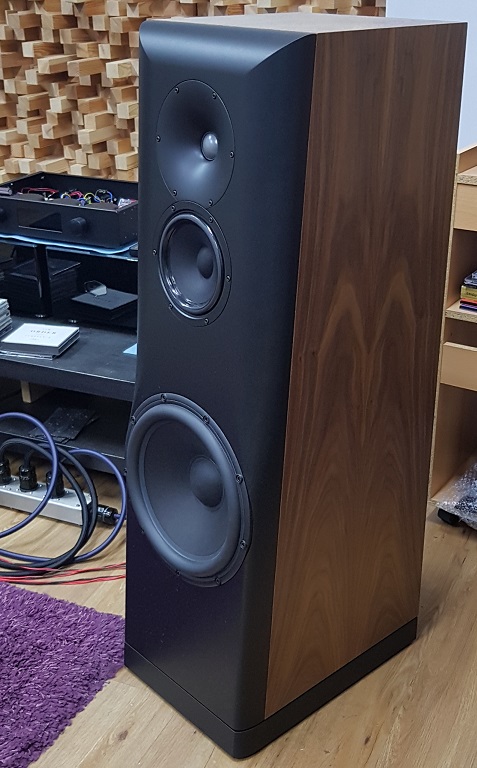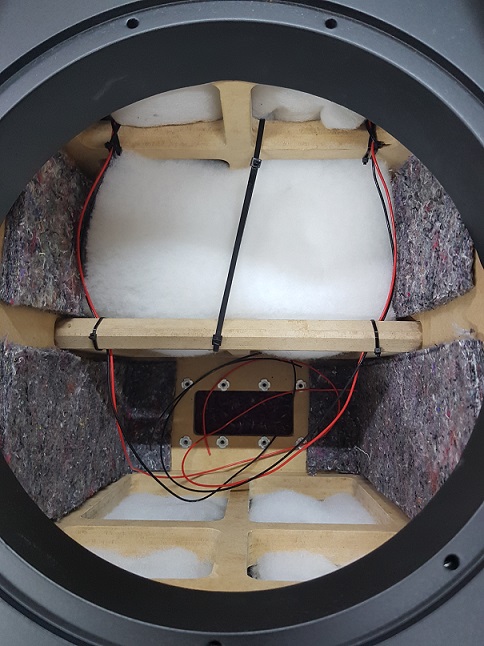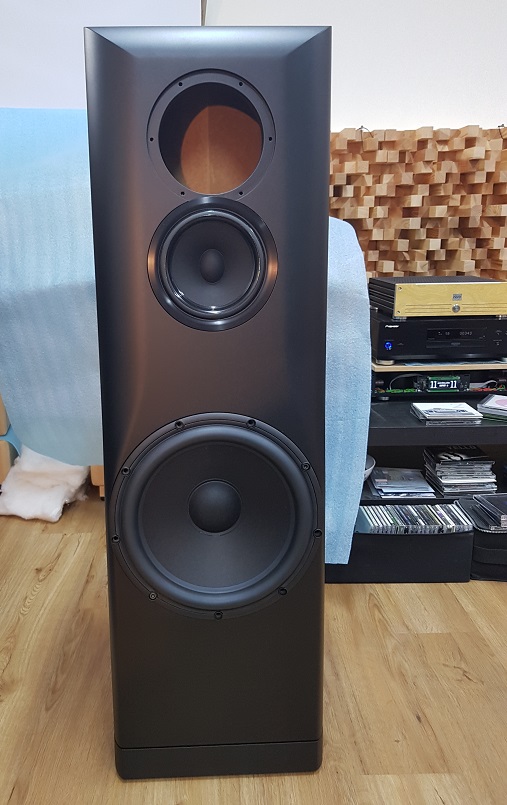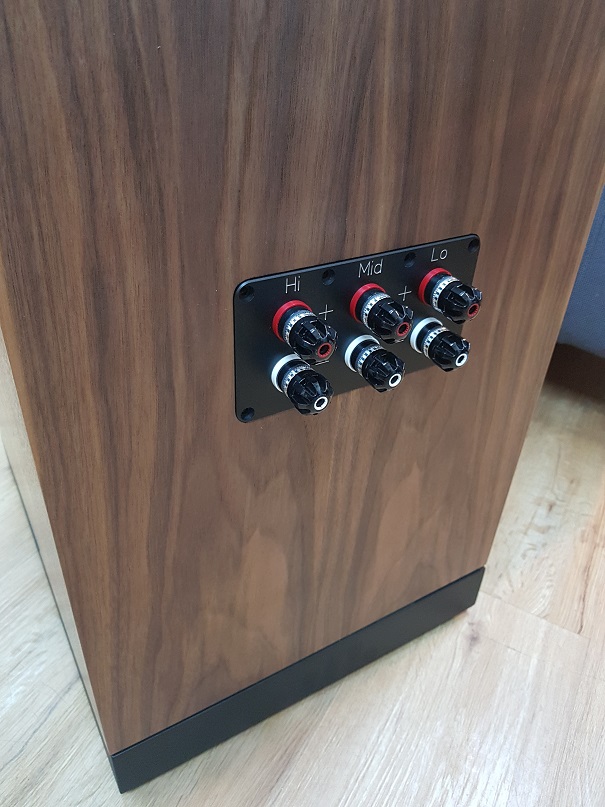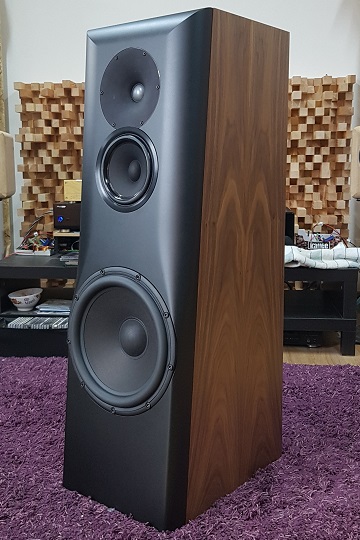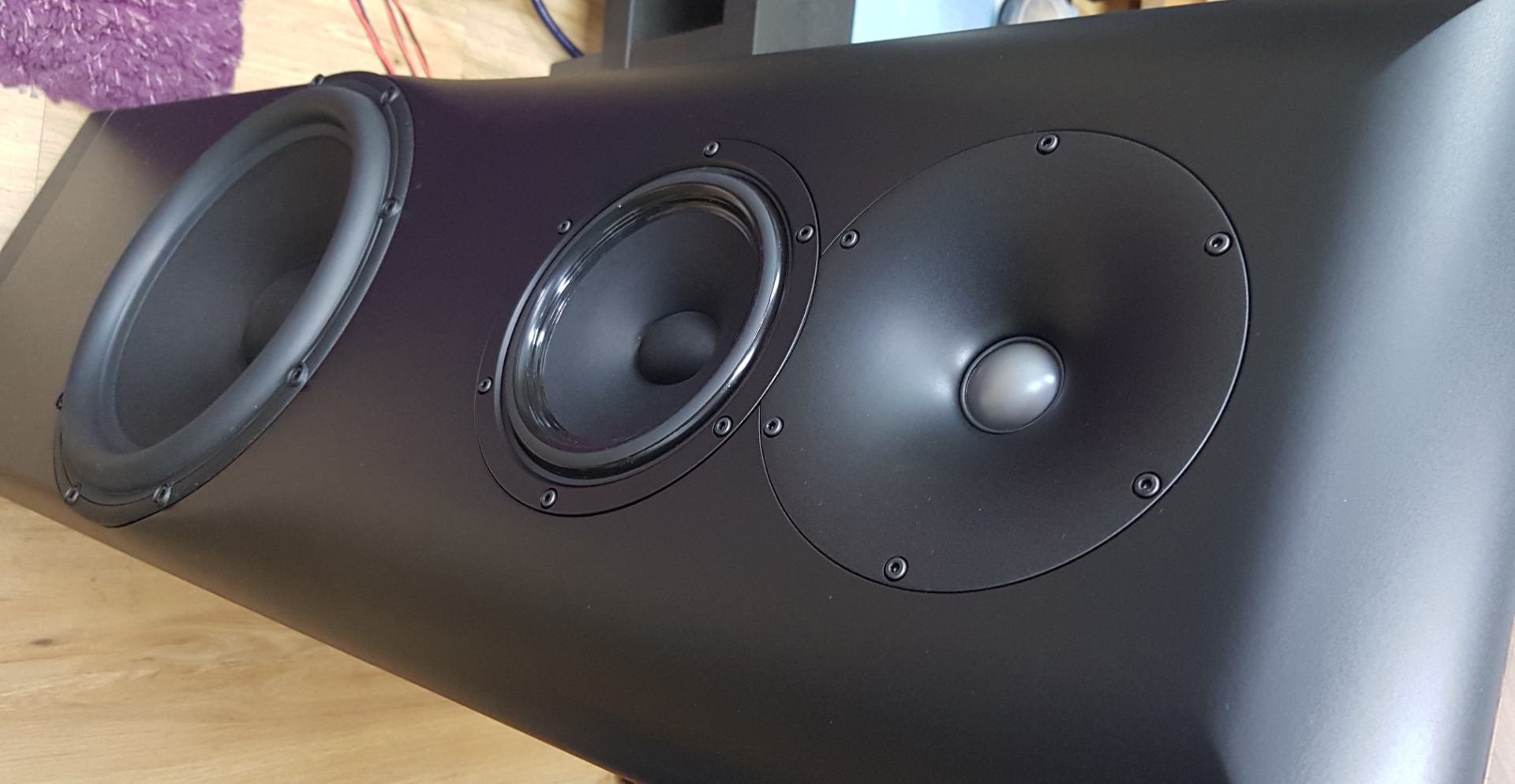
Ellips-A
3way large active floorstander WMT 12"+6"+1.5"+WG
Drivers: Scan Speak 32W/4878T00, 18WE/4542, Bliesma T34B + 6" Waveguide
Active crossover: Octo DAC 8 channels, nanoSHARC DSP
Power amplifiers: 3x stereo amp BV Audio PA300SSE
Woofer alignment: closed box, 75l net volume
Dimensions: H1100 x W340 x D460
Cabinet finish: walnut veneer
Design concept: This is kind of a loudspeaker I dreamt of for a long time. Such a project consolidates all design choices from my previous projects, listening experiences and drivers sonic characters and my overall design approach I developed during the years. Basic concept was clear and simple, WMT with 12inch woofer, though that is where simplicity ends. Since the beginning I knew that overall look would be similar to BBB project, as this solution works very well technically and acoustically, but is also very elegant which was confirmed by the responses from DIYers.
I would characterize all drivers here as very best money can buy. There is still not much DIY projects with these drivers on the internet and it is no wonder, considering their costs. 32W Revelator has been around already for a years and I have been planning this driver for my dream project. Bliesma and Ellipticor are quite new, and fortunatelly all of them were tested by Hificompass which made my decision easier.
Woofer: this project was great opportunity to get my hands on 32W revelator series. I have already listened to 32W/x878T00 with dual 30W passive radiators in Xavian Opus Magnum and was very impressed. Also my listening experiences of 26W Revelators and 28W Revelator supported the decision for 32W. Whole 32W Revelator series has great measurements and distortion numbers, can easily be crossed over at up to 500Hz in 3way system and work in reasonable cabinet volume <100liters. I have been considering T00, T01 and even T11. T01 would be obvious choice as good midpoint from whole series. It models well in ~80l ported cabinet. But looking at T00 and T11, I was tempted to make either system with higher sensitivity or closed box/pasive radiator box alignments. As this project is active, I decided for 4878T00 as it models great in closed cabinet and FR can be easily equalized, T00 has +-14mm linear excursion so it is ideal for this application. Modelling promises -6dB at 30Hz.
Tweeter: After listening experience of T25B I was sure I wanted to have T34B here. Good directivity match to midrange, acoustic center shifted backwards and aligned with midrange, minimized diffractions.....these are all good features and I wanted this project to implement all of them so I had to come with WG. Fortunatelly I had one available, developed for Scan Speak tweeters. Initially I estimated T34B surround to be approximatelly same as WG throat diameter. Tweeter grill removal was not easy decision either. I had to be very careful with screw drivers around the dome as it has very powerful magnet. Grill came off quite easily so I tried to fit the waveguide and it showed to have exactly same throat diameter as need for the dome. Initial measurements also proved T34B+WG combo to perform perfectly.
Midrange: T25B proved to be very good sonic match to Scan Speak Illuminator drivers, their characters are very similar, so 18WU paper was my initial choice. 18WU has cone edge resonance as many 6-7" drivers, fortunatelly not emphasized as much as Satori paper. But 18WE Ellipticor appeared on the market, 3rd party measurements showed great measured performance, and I could not resist. Cone edge resonance is still there, visible in freqency response and impedance, but is very well controlled and does not cause any distortion peaks nor the decay ridge in waterfall graph. 18WE closer examination reveals cone edge treatment on the outside of the surround both inner and outer edge. It is nice to see this solution though there are other possibilities to mitigate cone edge resonance. Audiotechnology SDKM midrange has triangle profile of the surround and to my knowledge and measurements it behaves very well in 1-2kHz area. Other solution would be double roll surround. Anyway, it seems manufacturers tend to neglect this issue and therefore we do not see those solutions often. I also have to admit I do not understand 18WE +-7mm linear excursion, while TS parameters and alignment modelling show this driver is not much suitable for BR alignment. All this makes me think this driver is midrange driver and as such it could have shorter excursion and surround optimized for midrange duty.
Such a expense for just midrange drivers was very hard to rationalize, but this kind of project deserves the best, it is also fun and exciting to work and listen to new driver, and moreover, budget allowed for such a expense.
Crossover: active crossover, OctoDAC with 8 channels and nanoSHARC. Tweeter protection in active system is frequently discussed topic, so I will model tweeter crossover with protective capacitor in series with tweeter.
Cabinet and front baffle: closed box makes whole construction little bit easier. Whole cabinet is constructed from 3mm MDF sheets, laminated to 25mm thick board. This makes whole cabinet heavy. There are also several brackets, every 15cm of cabinet height. Front baffle is 55mm thick, 5mm runs into the cabinet. I wanted this cabinet as slim as possible (if we can call any cabinet with 12inch woofer slim), but 32W dictates overall cabinet width. I let woofer basket to run out of the baffle rounding and this was very difficult detail for carpenter to make right and nice.
Front baffle consists of two types of roundovers, both have elliptical profile, small one around woofer, and large one for mid and tweeter part. In combination with WG this all eliminates any diffractions. Baffle tilt is 5deg. This was not unneccessary as it is possible to set needed delays in DSP, but tilted version was chosen for its better look.
There is chamber at the bottom of the cabinet, it stays empty for active version, but can be used for passive crossover eventually.
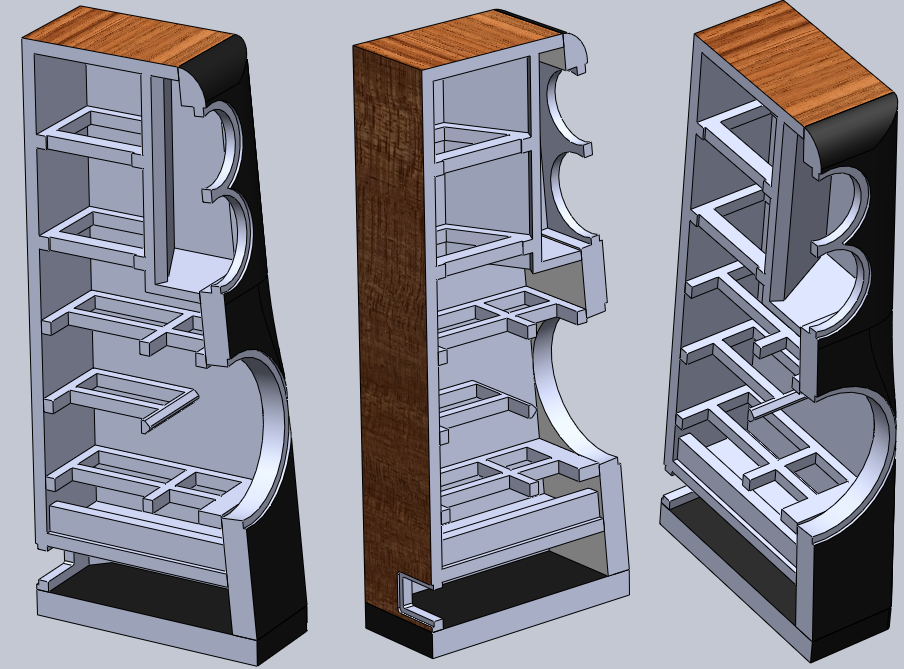
Plinth contains 4 flush mounted wheels for easy positioning of the loudspeaker.
Drivers measurements
I took horizontal measurements 0-180deg, but only 0-90deg angles are shown below. Measurement was done in very large space, tweeter axis was ~2.5m above the floor.

I already measured T34B WG combo some time ago, to be sure it performs well and can be used in this project. It was measured in slim standmount cabinet with R30 roundovers, so I was curious to see how it performs here in much wider cabinet with larger roundouvers. It is good to see perfectly smooth on axis and off axis responses, free of any diffractions. This is the moment where all the work with front baffle pays off. Directivity index in 1-2kHz matches 18WE DI, which promises good overall off axis response. I used two foam seal rings between tweeter and waveguide, and it is good to see clean waterfall and impedance graphs, free of any resonances.
Distortion measurements of the drivers look great. Generally all drivers show low H2 ~-55dB, low higher distortion orders, and consistent profiles. 18WE shows the signs of cone edge resonance 1-2kHz, H3 is elevated in that area, but still very low, and it is visible only because H3 below and above this area is even lower at ~-75dB. Cone edge treatment obviously does a good job here. The only downside of 18WE is the decor ring. The first 18WE measurement sweep revealed loud and clear resonances, removal of the ring and running the sweep again confirmed the ring really resonated. Distortion graphs were measured without decor ring, because area 100-1000Hz was otherwise totally ruined with the resonances and elevated distortion levels. Some foam gasket below the ring improved the situation, but the only solution was to manufacture new rings and run the bolts through the ring and the driver. Anyway, this decor ring thing is not good thing, generally useless and just adding a cost to a driver. I prefer standard six bolts speaker chassis, as decor rings are usually what we can see in cheap loudspeakers using stamped frame drivers.
32W measurements look great and we can approximate f-10 point at 20Hz which is very low and matches the modelling with TS parameters. This is true measured response, no "theoretical room gain improved" numbers. With DSP it is possible to equalize the low end, but I do not think it will be needed. There are two breakups at 800 and 2000Hz that will need to be taken care of in the crossover. Distortion below 100Hz is perfect, very low and even above 100Hz we can talk about very low distortion numbers. Though this driver is marked as subwoofer I do not have any objections to use it as woofer crossed over below 300Hz. Waterfall graph is very clean below 800Hz and I assume this is the result of closed box alignment.
Description of the measurements below:
1. Frequency responses 0-90deg
2. Spinorama set, important mainly for Directivity index (evaluation of driver matching at Fc)
3. Distortion measurement H2-H6
4. Waterfall graph, generated from distortion measurement data, which means mic 30cm, 2.83V
5. Impedance of each driver in the cabinet
Crossover modelling
Preliminary crossover modelling of active version looks very good...... Off axis response 0-180deg shown.
Tweeter has protection capacitor ~1.5uF in series, and such a small value compensates WG boost. It also allows to use high quality capacitor, as larger capacitors tend to be expensive.
After LR2 and LR4 comparison it is clear LR4 is way to go and this is current setting. Evaluation is ongoing....
....and how it all sounds...
There are always some expectations when I start new project and this one was not different. Actually I had the highest expectations from all of my projects. To make it short, my expectations were exceeded. Details follow.....
In concept phase one of my worries was if natural response of 32W in closed alignment would be sufficient in terms of extension at low frequencies. After listening tests I decided to keep natural woofer rolloff and not to apply equalization. One thing that is immediately noticeable is how loud one can listen without unpleasure sense of room pressurization while bass quality remains perfect, firm, short and fast (I know I know, I am just trying to express my subjective impressions compared to experiences with bassreflex systems). Even at high volumes I wanted to try to add the volume but the sense of sanity kept me from doing that.
Midrange and treble quality follow and well complement the bass qualities. The sense of detail and clarity is partially caused by closed woofer alignment but also perfect drivers. Bliesma trebles are very different to well known Scan Speak fabric domes and ring radiators (mentioning these because I know them and consider them one of the best tweeters available (7100, 7000, 6600, 6620,....)). Bliesma tweeters are not forgiving and it takes hours and hours of the listening and fine tuning of treble level. Once you hit the sweetspot Bliesma treble quality is excellent. It has a lot of body but also air at the highest frequencies giving the sense of unlimited top extension. T34B sounds a lot like T25B which I have already experience. 18WE is very good character match to Bliesma. I have already made project with 12MU and 25B and based on this I decided for 18WE for Ellips-A.
There are essential sonic characteristics I always want to imprint to my projects and this one was not an exception.
The first, loudspeaker should play all music genres well. Anytime I read the review of loudspeakers mentioning they are excellent for jazz etc and not good for rock etc I have feeling there must be certain design flaws in such a loudspeaker. Of course nobody expects 6+1 2-way to be great for loud rock listening, but despite its limitations the rock still should sound well without the feeling something is wrong or weird.
The second, all bands should be well merged and not percieved as separated sources. This problem is typical for 2way + sub, or not well executed 3way. This is partially about woofer - midrange crossover placement, but also midrange level, port tuning and damping in the cabinet. In this case I had to move crossover from 180Hz to 230Hz.
The third, loudspeaker must play well at low and even high volumes. This is not easy to achieve. Of course one can tune the loudspeaker to be forgiving so easy to listen at high voleme but such a tuning usually adversely effects quality of low level reproduction. And vice versa, one can add more sparkle to trebles by lifting the area above 3000Hz, and this gives good detail and sparkle at low volumes, but for higher volumes it quickly leads to listening fatique.
These three key criteria probably appear as clear and something all loudspeakers should easily met, but in reality these are quite problematic for many loudspeakers.
And few word on active solution, DSP and DAC quality. Several experienced listeners mentioned among all the qualities also some sense of unification or character that is in all played CDs and genres and mild harshness. Of course I spent a lot of time fine tuning treble and midrange response but this impression was still apparent. We agreed this is the limitation of DSP and DACs and my next efforts will still go passive loudspeaker route.
Photos
